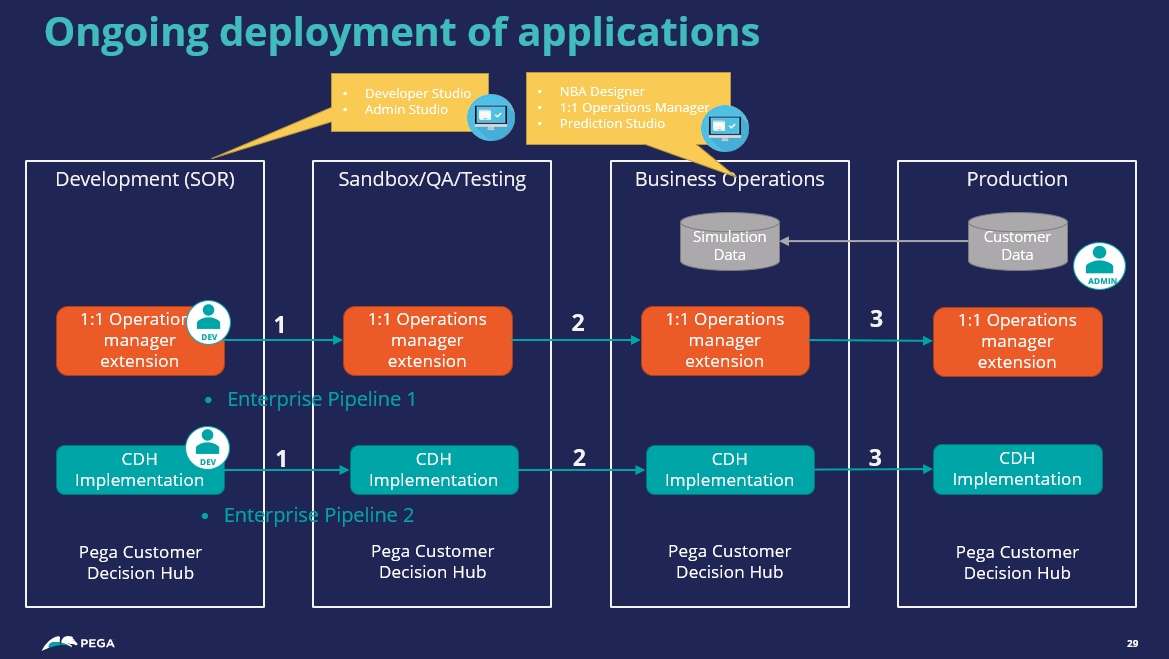Managing changes in Pega Customer Decision Hub environments
Pega Customer Decision Hub is a Pega application intended to be configured and extended in a development environment, and then migrated to higher environments. At the same time, changes to business artifacts are made in the Business Operations Environment. These changes follow a separate change management process that allows clients to support two works streams.
This document provides detailed guidance for delivery teams looking to enable this with Customer Decision Hub using Pega 1:1 Operations Manager. The document also describes DevOps best practices that ensure your application can be maintained in the future.
Initial deployment and migrating entire applications to higher instances
Pega Customer Decision Hub implementation requires a deployment architecture with four environments and the change pipelines for deploying changes to the environments.
Configure the Development (system of records) environment to include the following applications:
| Application name | Built on application | Users | Notes |
| 1:1 Operations Manager overlay application |
| NBA Specialist, Team Leader, Business User, Customer Decision Hub Manager, Revision Manager | This is the end-user runtime application. Enhancements to 1:1 Operations Manager cannot be made in this application. |
| 1:1 Operations Manager extension |
| Developer, QA Tester | Enhancements to 1:1 Operations Manager are done here. These include changes to UI, cases, stages, flow and assignment routing. |
| Customer Decision Hub |
| Customer Decision Hub Admin, Customer Decision Hub Manager, Customer Decision Hub Analyst | Enhancements to core Customer Decision Hub are done here. These include Context Dictionary configuration, integrations, custom attributes, and others. |
As a best practice, configure all three applications in the Development environment.
Then, once all applications are validated and smoke tested, migrate them using the
initial deployment pipeline.
Enterprise changes
Enhancements to application functionality are made through standard developer
practices like branching and ruleset lock and roll. Enhancements can be made for
both, the Customer Decision Hub implementation application, and the
1:1 Operations Manager extension application. These
enhancements are typically handled in the Rules ruleset, or in client-specific
rulesets. For the 1:1 Operations Manager extension application,
enhancements are handled in client-specific rulesets. No changes to the overlay
application should be migrated from development after the initial deployment. These
changes are migrated to higher environments using the Enterprise pipeline.
Business changes
Ongoing business changes include changes to next best actions, treatments, models, Next-Best-Action Designer configurations, contact policy, and similar artifacts. These changes are completed in the Business Operations Environment and should be quickly tested in lower environments.
The changes are handled through the Revision functionality, and are packaged automatically for you when using 1:1 Operations Manager.
Once users start using 1:1 Operations Manager, you need to include
Next-Best-Action Designer under change management as well. The artifacts should be
first deployed to Development, then higher environments to Production. Testing for
these changes would be done in each environment by running specific tests that are
appropriate in that environment. These changes are migrated using the Business
change pipeline.
Orchestrator
Your system also requires an orchestrator to manage the migration of changes through the change pipelines. In Pega Cloud services deployments, the default orchestrator is Deployment Manager.
Deployment pipelines
Customer Decision Hub supports the following primary types of pipelines from a DevOps perspective:
- Enterprise changes
- Enterprise changes involve changing the application itself, for example, by modifying the user interface. Enterprise changes are done by developers in a Development system of record (SOR) environment, and then pushed to other environments in the pipeline.
- Business changes
- Business changes involve business-as-usual operations such as the creation of new actions, treatments, customer segments, and so on. This type of change is triggered by business users in a BOE environment, and then pushed to other environments by using the Business Change pipeline.
- Data migration
- The automated data migration pipeline provides you with the means to test how the changes that you make to decision strategies affect their results, without running these strategies in a live production environment. You can sample a selection of real customer and internal Pega Platform data, and then migrate the sample to the BOE environment. As a result, the simulations are based on the migrated production data, that is, customer details, adaptive model data, and interaction history, which helps you assess how your changes are reflected in real-life scenarios. For more information, see Data migration pipeline overview.
For more information about the recommended pipeline setup, see Pipelines.
Previous topic Prerequisites for Pega Customer Decision Hub Next topic Configuring the Development environment
